Презентація на тему «Longfellow»
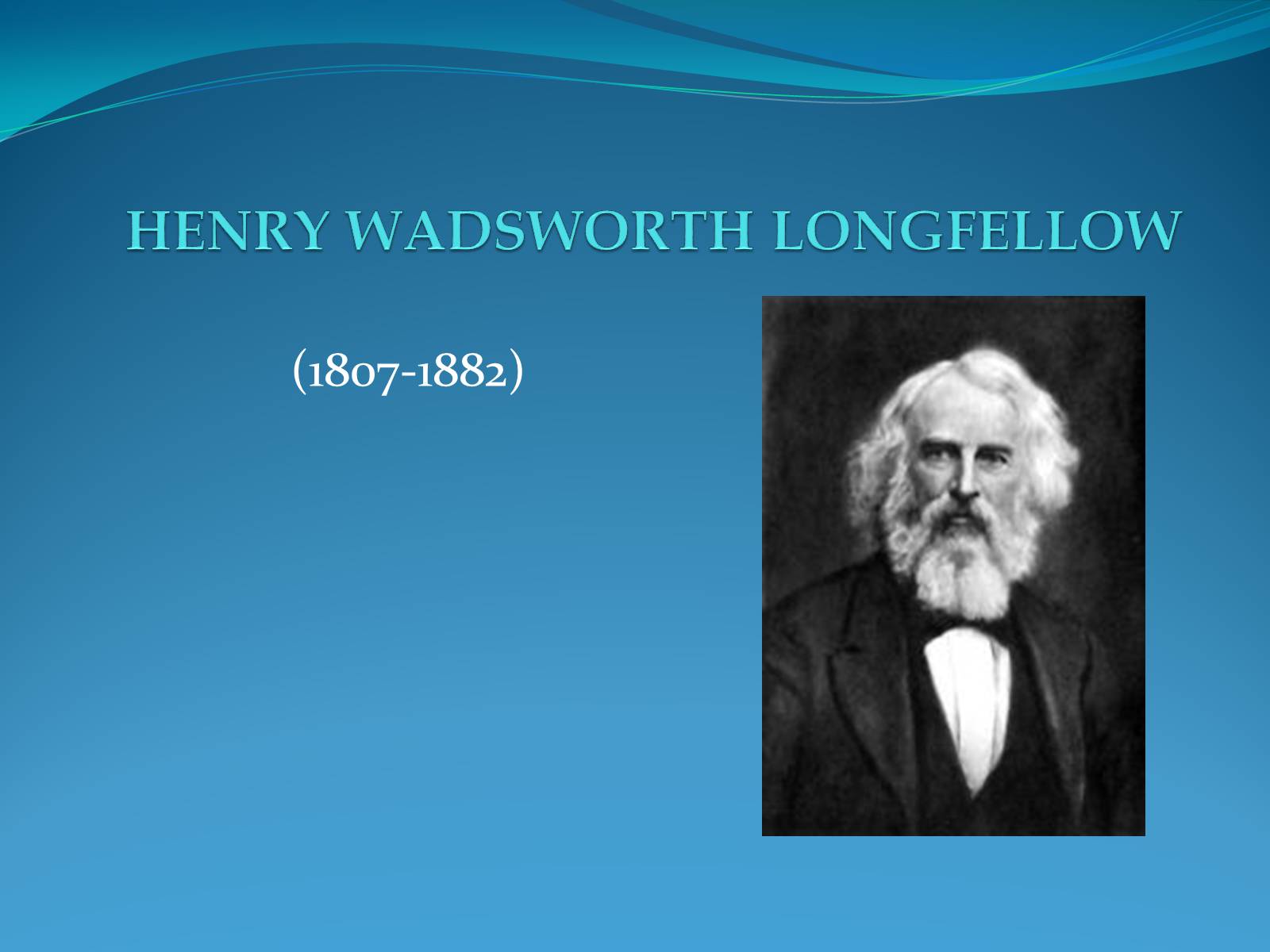
HENRY WADSWORTH LONGFELLOW
(1807-1882)
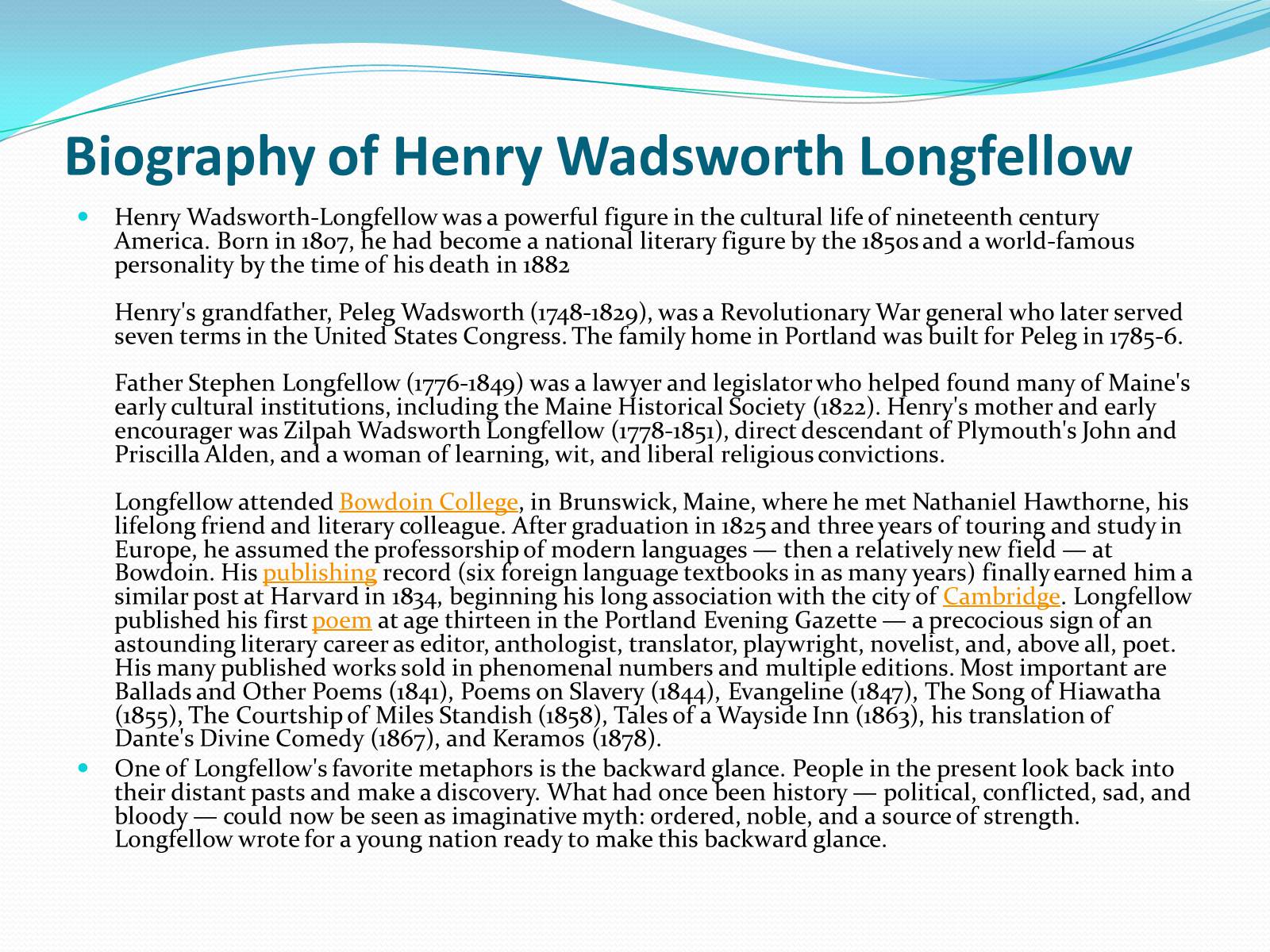
Biography of Henry Wadsworth Longfellow
Henry Wadsworth-Longfellow was a powerful figure in the cultural life of nineteenth century America. Born in 1807, he had become a national literary figure by the 1850s and a world-famous personality by the time of his death in 1882 Henry's grandfather, Peleg Wadsworth (1748-1829), was a Revolutionary War general who later served seven terms in the United States Congress. The family home in Portland was built for Peleg in 1785-6. Father Stephen Longfellow (1776-1849) was a lawyer and legislator who helped found many of Maine's early cultural institutions, including the Maine Historical Society (1822). Henry's mother and early encourager was Zilpah Wadsworth Longfellow (1778-1851), direct descendant of Plymouth's John and Priscilla Alden, and a woman of learning, wit, and liberal religious convictions. Longfellow attended Bowdoin College, in Brunswick, Maine, where he met Nathaniel Hawthorne, his lifelong friend and literary colleague. After graduation in 1825 and three years of touring and study in Europe, he assumed the professorship of modern languages — then a relatively new field — at Bowdoin. His publishing record (six foreign language textbooks in as many years) finally earned him a similar post at Harvard in 1834, beginning his long association with the city of Cambridge. Longfellow published his first poem at age thirteen in the Portland Evening Gazette — a precocious sign of an astounding literary career as editor, anthologist, translator, playwright, novelist, and, above all, poet. His many published works sold in phenomenal numbers and multiple editions. Most important are Ballads and Other Poems (1841), Poems on Slavery (1844), Evangeline (1847), The Song of Hiawatha (1855), The Courtship of Miles Standish (1858), Tales of a Wayside Inn (1863), his translation of Dante's Divine Comedy (1867), and Keramos (1878).
One of Longfellow's favorite metaphors is the backward glance. People in the present look back into their distant pasts and make a discovery. What had once been history — political, conflicted, sad, and bloody — could now be seen as imaginative myth: ordered, noble, and a source of strength. Longfellow wrote for a young nation ready to make this backward glance.

Marriage to Frances "Fanny" Appleton
Longfellow began courting Frances "Fanny" Appleton, the daughter of a wealthy Boston industrialist, Nathan Appleton. During the courtship, he frequently walked from Harvard to her home in Boston, crossing the Boston Bridge. That bridge was subsequently demolished and replaced in 1906 by a new bridge, which was eventually renamed as the Longfellow Bridge.
After seven years, Fanny finally agreed to marriage, and they were wed in 1843. Nathan Appleton bought the Craigie House, overlooking the Charles River as a wedding present to the pair. The house was occupied during the American Revolution by General George Washington and his staff.[4]
His love for Fanny is evident in the following lines from Longfellow's only love poem, the sonnet "The Evening Star", which he wrote in October, 1845: "O my beloved, my sweet Hesperus! My morning and my evening star of love!"
He and Fanny had six children:
Charles Appleton (1844-1893)
Ernest Wadsworth (1845-1921)
Fanny (1847-1848)
Alice Mary (1850-1928)
Edith (1853-1915), who married Richard Henry Dana III, son of Richard Henry Dana
Anne Allegra (1855-1934)
When the younger Fanny was born on April 7, 1847, Dr. Nathan Cooley Keep administered the first obstetric anesthetic in the United States to Fanny Longfellow.
Longfellow retired from Harvard in 1854, devoting himself entirely to writing. He was awarded an honorary doctorate of Laws from Harvard in 1859.

Frances "Fanny" Appleton
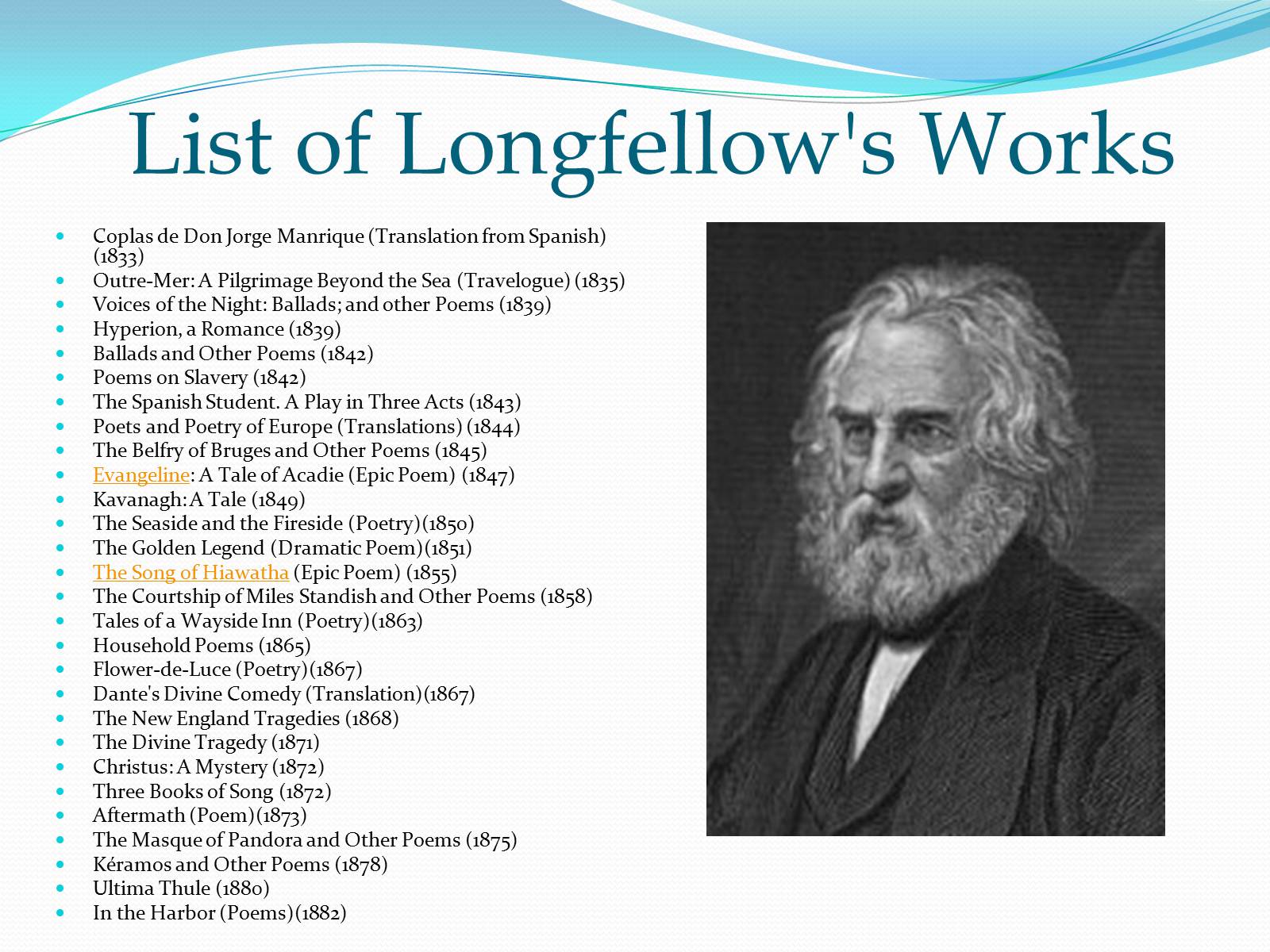
List of Longfellow's Works
Coplas de Don Jorge Manrique (Translation from Spanish) (1833)
Outre-Mer: A Pilgrimage Beyond the Sea (Travelogue) (1835)
Voices of the Night: Ballads; and other Poems (1839)
Hyperion, a Romance (1839)
Ballads and Other Poems (1842)
Poems on Slavery (1842)
The Spanish Student. A Play in Three Acts (1843)
Poets and Poetry of Europe (Translations) (1844)
The Belfry of Bruges and Other Poems (1845)
Evangeline: A Tale of Acadie (Epic Poem) (1847)
Kavanagh: A Tale (1849)
The Seaside and the Fireside (Poetry)(1850)
The Golden Legend (Dramatic Poem)(1851)
The Song of Hiawatha (Epic Poem) (1855)
The Courtship of Miles Standish and Other Poems (1858)
Tales of a Wayside Inn (Poetry)(1863)
Household Poems (1865)
Flower-de-Luce (Poetry)(1867)
Dante's Divine Comedy (Translation)(1867)
The New England Tragedies (1868)
The Divine Tragedy (1871)
Christus: A Mystery (1872)
Three Books of Song (1872)
Aftermath (Poem)(1873)
The Masque of Pandora and Other Poems (1875)
Kéramos and Other Poems (1878)
Ultima Thule (1880)
In the Harbor (Poems)(1882)

The Village BlacksmithManuscript
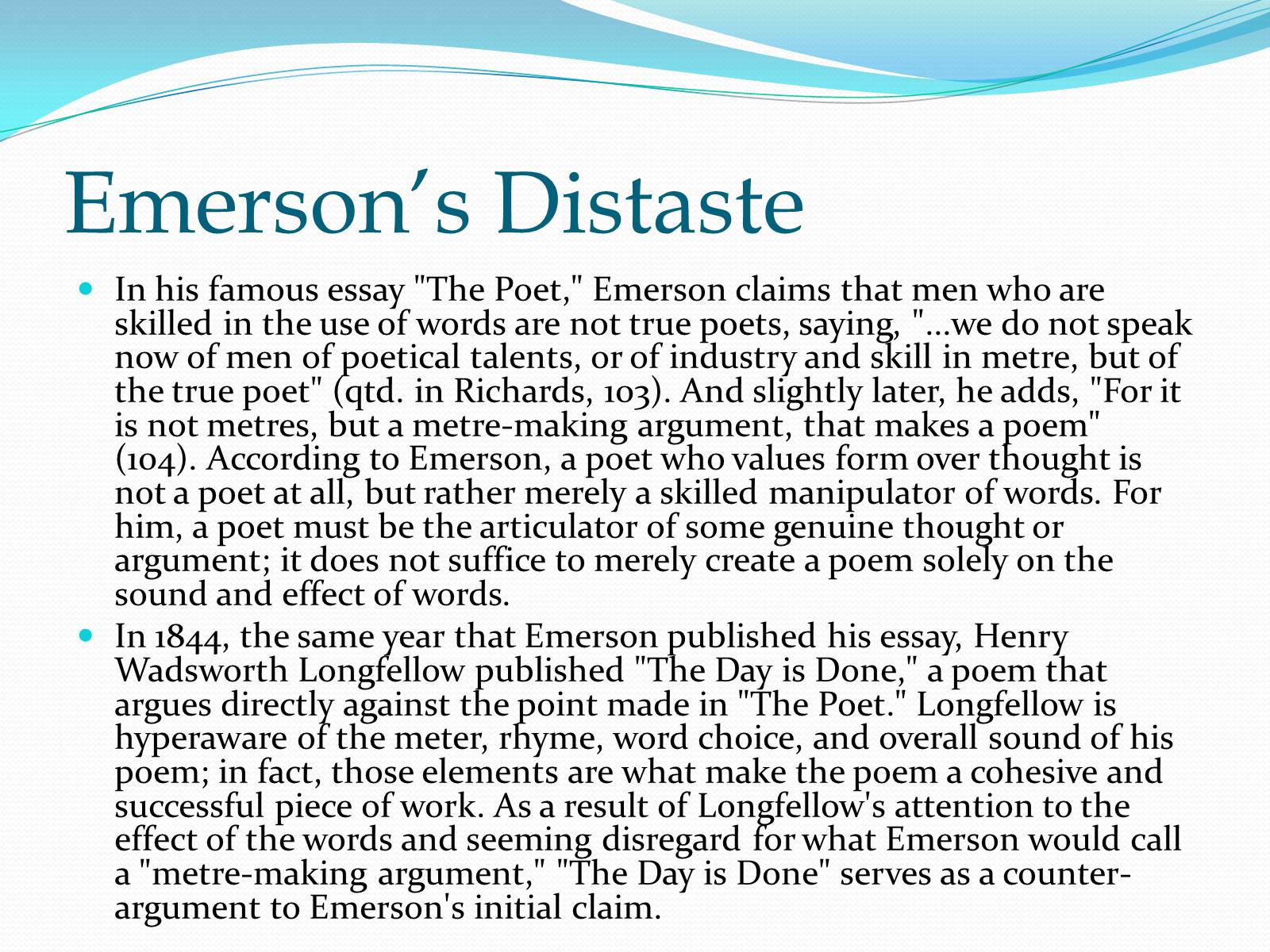
Emerson's Distaste
In his famous essay "The Poet," Emerson claims that men who are skilled in the use of words are not true poets, saying, "...we do not speak now of men of poetical talents, or of industry and skill in metre, but of the true poet" (qtd. in Richards, 103). And slightly later, he adds, "For it is not metres, but a metre-making argument, that makes a poem" (104). According to Emerson, a poet who values form over thought is not a poet at all, but rather merely a skilled manipulator of words. For him, a poet must be the articulator of some genuine thought or argument; it does not suffice to merely create a poem solely on the sound and effect of words.
In 1844, the same year that Emerson published his essay, Henry Wadsworth Longfellow published "The Day is Done," a poem that argues directly against the point made in "The Poet." Longfellow is hyperaware of the meter, rhyme, word choice, and overall sound of his poem; in fact, those elements are what make the poem a cohesive and successful piece of work. As a result of Longfellow's attention to the effect of the words and seeming disregard for what Emerson would call a "metre-making argument," "The Day is Done" serves as a counter-argument to Emerson's initial claim.
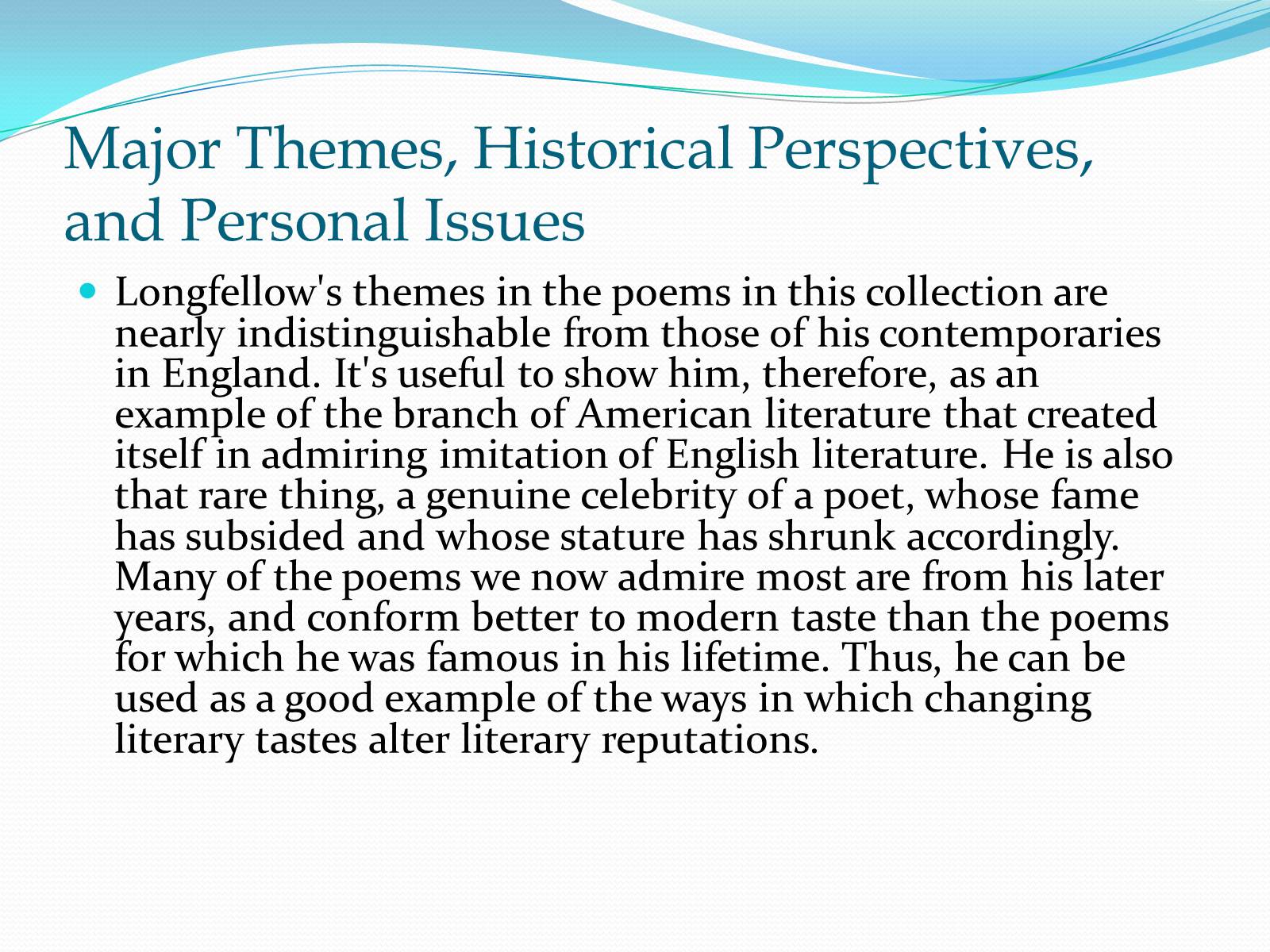
Major Themes, Historical Perspectives, and Personal Issues
Longfellow's themes in the poems in this collection are nearly indistinguishable from those of his contemporaries in England. It's useful to show him, therefore, as an example of the branch of American literature that created itself in admiring imitation of English literature. He is also that rare thing, a genuine celebrity of a poet, whose fame has subsided and whose stature has shrunk accordingly. Many of the poems we now admire most are from his later years, and conform better to modern taste than the poems for which he was famous in his lifetime. Thus, he can be used as a good example of the ways in which changing literary tastes alter literary reputations.

Significant Form, Style, or Artistic Conventions
Longfellow's poems are not only accessible in their meaning, but they are also highly regular in their form. It is very simple to teach metrics with Longfellow because he provides easy and memorable examples of so many metrical schemes. These can be presented in connection with Longfellow's personal history, for he is of course an academic poet, and as such a poet writing often self-consciously from a learned perspective. Thus, nothing with him seems wholly spontaneous or accidental.
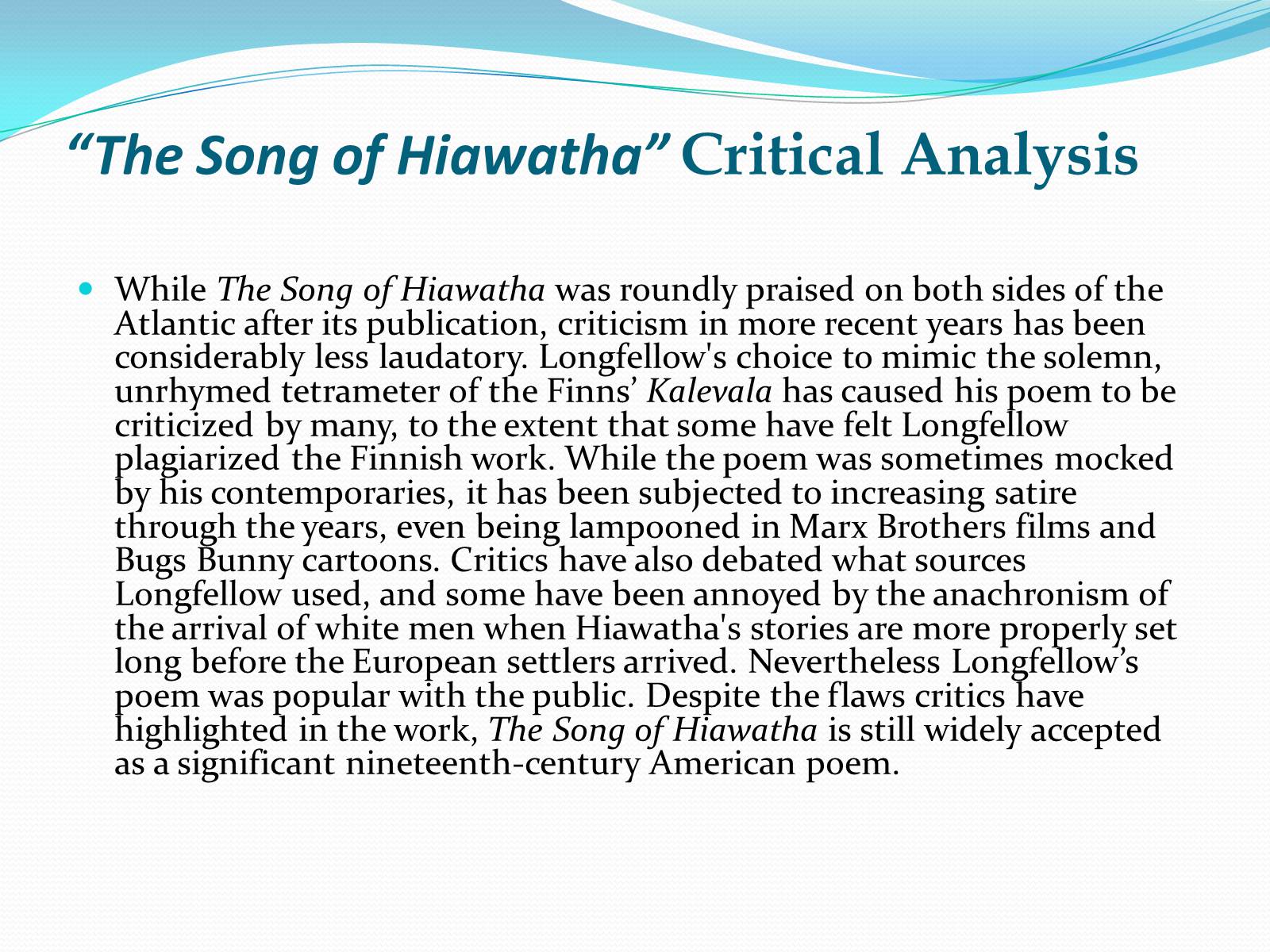
“The Song of Hiawatha” Critical Analysis
While The Song of Hiawatha was roundly praised on both sides of the Atlantic after its publication, criticism in more recent years has been considerably less laudatory. Longfellow's choice to mimic the solemn, unrhymed tetrameter of the Finns' Kalevala has caused his poem to be criticized by many, to the extent that some have felt Longfellow plagiarized the Finnish work. While the poem was sometimes mocked by his contemporaries, it has been subjected to increasing satire through the years, even being lampooned in Marx Brothers films and Bugs Bunny cartoons. Critics have also debated what sources Longfellow used, and some have been annoyed by the anachronism of the arrival of white men when Hiawatha's stories are more properly set long before the European settlers arrived. Nevertheless Longfellow's poem was popular with the public. Despite the flaws critics have highlighted in the work, The Song of Hiawatha is still widely accepted as a significant nineteenth-century American poem.